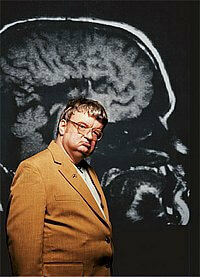Pick's disease
 Peak disease is a progressive CNS disease characterized by atrophy of the frontal and temporal lobes of the cerebral cortex and manifested by increasing dementia. The average age of onset of the disease is 50-60 years, although a later and earlier manifestation is possible. Women are sick more often than men. Due to the death of neutrons in this disease, the cerebral cortex becomes depleted, the grooves of the brain deepen, the cerebral ventricles increase significantly, and the boundary between the white and gray matter is erased
Peak disease is a progressive CNS disease characterized by atrophy of the frontal and temporal lobes of the cerebral cortex and manifested by increasing dementia. The average age of onset of the disease is 50-60 years, although a later and earlier manifestation is possible. Women are sick more often than men. Due to the death of neutrons in this disease, the cerebral cortex becomes depleted, the grooves of the brain deepen, the cerebral ventricles increase significantly, and the boundary between the white and gray matter is erased
. Disease is the cause of the onset of
. At present, the single-valued cause of the development of Pick's disease is not established. At the moment, scientists identify only a number of factors that increase the risk of its development:
- The main risk factor is considered a hereditary predisposition. In the event that blood relatives in old age were present with different types of dementia, it is necessary to be very wary and attentive to your condition
- Intoxication. In the case of prolonged exposure to the body of various chemicals, the chance of developing Pick's disease is significantly increased. Anesthesia can also be attributed here, since for the nervous system this is a very difficult procedure for
- Head trauma. Due to the fact that the disease manifests itself as the death of neurons, head injuries are also considered one of the risk factors for
- Migrated mental illnesses. In a person with a depressive psychosis, the risk of developing dementia is significantly increased
Peak Disease -
Symptoms At the initial stage of the development of Pick's disease, a profound personality change and signs of changing the most complex types of intellectual activity come to the forefront of the long enough period of time. The disease develops gradually and imperceptibly. One of the initial symptoms is the disappearance of a critical attitude towards the environment and its condition, which is one of the main symptoms of developing total dementia. In parallel with this, the mobility and productivity of thinking decrease, the level of judgment decreases, and the emotionality progressively decreases. At this stage, the patient is well preserved memory and spatial orientation. In some cases, along with growing dementia, there is a shallow depression, manifested by tearfulness and undiluted delusions of damage. Also sometimes, patients may experience headache, weakness, dizziness. With the growth of dementia, this symptomatology disappears.
Depending on the place of localization of the atrophic process, there is a change in the clinical manifestations of the disease. In the case of a lesion of the basal cortex, the patients are fussy, mobile, can pester others and make them tactless inappropriate comments, they have an increased-careless state( pseudoparalytic syndrome).In the case of lesions of the frontal lobes, inactivity, apathy and lethargy prevail in patients. In the case of predominance of the atrophic process in the frontotemporal and frontal lobes, the emergence of focal disorders predominates, in particular speech stereotypes.
With the unfolded picture of Pick's disease, symptomatic of focal cortical disorders joins dementia already developed. The decay of expressive speech is taking place, the vocabulary is noticeably impoverished, and sometimes it can be limited to a few short phrases or words;The semantic content of speech is simplified, its grammatical structure is violated. Understanding someone else's speech is noticeably worse. Speech stereotypes typical for Pick's disease develop, which manifest themselves in the same type of answers to absolutely different questions. Sometimes the answers are so detailed that they are like short stories. After a certain period of time, the speech is noticeably sparse and the patient usually answers one of the most varied questions with one, less often a few words. Characteristic symptoms of the decay of expressive speech include echolalia( often accompanied by echopraxia) and Palilalia. Sometimes, when the expressive speech collapses, violent singing or speaking is manifested, which is limited to the pronunciation of one phrase. These disorders are also referred to as speech stereotypes.
In the behavior and writing, the patient has a so-called "standing turns".For example, a patient every time, seeing a funeral procession from a window, leaves the house, comes with her to the cemetery and returns back. The development of the following cortical disorders can be observed: apraxia, alexia, acalculia, agraphia and amnestic aphasia. U30% of patients develop neurological disorders in the form of extrapyramidal choreopodic hyperkinesis and amyostatic syndrome. Paroxysmal conditions can also be observed in the form of loss of muscle tone with a subsequent fall, not related to epileptic seizures and not accompanied by a disturbance of consciousness.
In patients with Peak's disease in the marked stage of development, in most cases excessive body weight( obesity) is observed. In the terminal stage there is violent laughter and crying, oral and grasping automatisms, there is an increasing cachexia, speech and any signs of mental activity disappear.
Diagnosis of
Peak Disease Patient with suspicion of Pick's disease is examined by a psychiatrist. First of all, on the basis of personal conversation and general superficial examination of the patient, the doctor assesses the current state of the neuropsychic sphere. First of all, the preliminary examination should reveal the inadequacy of actions and the violation of social behavior. To assess the state of the brain, the following methods are prescribed:
- CT( computed tomography).This type of diagnosis allows you to obtain layered high-precision images of the brain. CT allows you to determine the degree of progression of the process and identify the most affected part of the brain
- Electroencephalography. This method is based on the ability of special equipment to capture the minimal electrical impulses that appear in the human brain, appearing during the signaling. Data on the received pulses are displayed on a sheet of paper as a set of curves. In the case of Pick's disease, the cortex becomes thinner, correspondingly, the processes in it take much less, which accordingly reflects the electroencephalogram.
-MRI or magnetic resonance imaging presents the same diagnostic significance as CT
. In Pick's disease, it is necessary to carry out differential diagnosis with diseases such as illnessAlzheimer's, Huntington's chorea, brain cancer, mental disorders in diffuse atherosclerosis
Peak disease - treatment
Etiotropic therapy, oralanyayuschaya Pick's disease does not yet exist. Unfortunately, no therapy has been developed at this time, which makes it possible to stop the progression of the disease even at some stage.
First of all, people with Pick's disease need care and constant care. In view of this deplorable state, they are unable not only to live on their own, but they can also carry a certain danger to themselves and others( to open without burning household gas, etc.).
Currently, treatment for Pick's disease is in the following areas:
- Substitution therapy. The patient is supposed to take those substances that, due to atrophy, are not produced in the brain( antidepressants, MAO inhibitors, acetylcholinesterase inhibitors, etc.).
- Admission of anti-inflammatory drugs
- Neuroprotectants. Stimulate brain cells, improving the metabolic processes in them, thereby contributing to the slowing down of the death of neurons followed by atrophy of the cerebral cortex
- Pharmacorrection of existing mental disorders. Used drugs that reduce aggression, antidepressants
- Continuous psychological support. Patients participate in special trainings aimed at slowing the progression of the disease
Prognosis of future life in case of Pick's disease is unfavorable. Five to ten years after the onset of the disease, a complete mental and moral decay of the patient's personality takes place, cachexia and insanity occur. Man for society is completely lost. The average life expectancy in Pick's disease is about six to eight years. Patients need mandatory permanent full care, which is best performed in a specialized psychiatric hospital
More articles on the topic:
1. Obsessive-compulsive disorder
2. Catatonic syndromes
3. Senile psychosis



